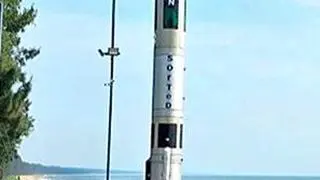Scientists at the Indian Institute of Science, Bengaluru, and a doctor from AIIMS, Bhopal, have developed a novel method for rapid testing for Covid-19 using what’s known as the Raman Spectroscopy (RS).
RS is a technique employed to analyse the chemical structure of a material using the property of scattering of light. When light, typically a laser beam, hits the matter that is to be examined, the molecules scatter the light. Most of the scattered light is of the same wavelength as the input beam, but a small amount is of a different wavelength — because the electrons either absorb a bit of the light’s energy, or lose some of its own energy when light particles hit them. The extremely small light of varied wavelength — called Raman scatter — gives an idea of the material that is being analysed.
IISc scientists Siva Umapathy (currently on deputation as the director of IISER, Bhopal), Dipankar Nandi and Chiranjib Bhattacharya, and Sarman Singh, a medical doctor at AIIMS, Bhopal, have developed a technique to test for viral infections using RS.
It works on the principle that every disease is associated with a change in the biochemistry of body fluids. The scientists ran thousands of samples of positive Covid-19 blood samples — provided by AIIMS, Bhopal — on Raman spectroscopes specially designed for this purpose, and collected the data of the scattered light. This way, they built a database of ‘spectral signatures’ of positive cases. Then they developed machine learning algorithms that compared a new blood sample with the database and conclude whether there was mild, moderate, severe infection, or none.
Typically, RS is a weak technique to use for such work, because there is an extremely small amount of scattered light that is of a different wavelength than the input light, to capture and analyse — 0.000001 per cent of the incident light. Raman scattering has been traditionally observed from samples at angles of 90, 135 or 180 degrees from the incident light. Also, the spectral signatures are those of the chemical species on the surface of the sample.
However, using UMARS, both chemicals deep inside the samples can be analyzed, using light scattered from all angles. Some years ago, Umapathy improved the technique, called the ‘universal multiple angle Raman spectroscopy’, or UMARS. This made it possible for the application of RS to test for Covid-19 infections.
The scientists started work on this project eight months ago with a view to building a portable Raman spectrometer with a stored database of tested viral respiratory diseases. They are now testing two prototypes — one at the DRDO, Pune, and the other at the Defence Bio-Engineering & Electro Medical Laboratory (DEBEL), Bengaluru.
How good is the system for Covid-19 test? Umapathy told Quantum that he was 80 per cent confident about it. It would be improved to 100 per cent by adding more data to the database.
Once the system is as good as the RT PCR, the most used Covid-19 test today, these Raman spectrometers would form a part of doctors’ toolkit to detect not just Covid-19 but any infection.








Comments
Comments have to be in English, and in full sentences. They cannot be abusive or personal. Please abide by our community guidelines for posting your comments.
We have migrated to a new commenting platform. If you are already a registered user of TheHindu Businessline and logged in, you may continue to engage with our articles. If you do not have an account please register and login to post comments. Users can access their older comments by logging into their accounts on Vuukle.